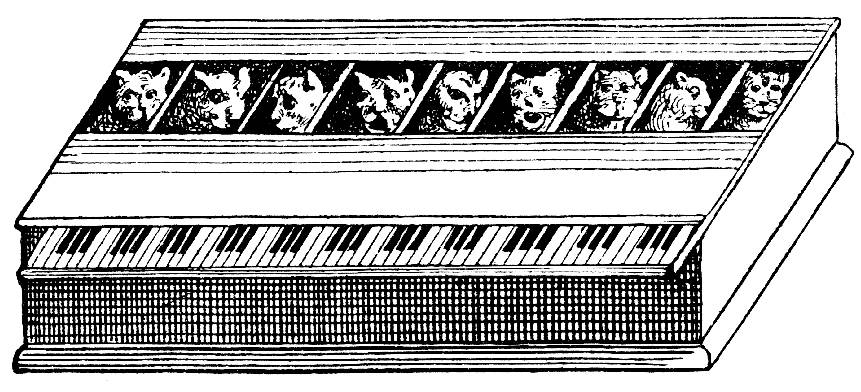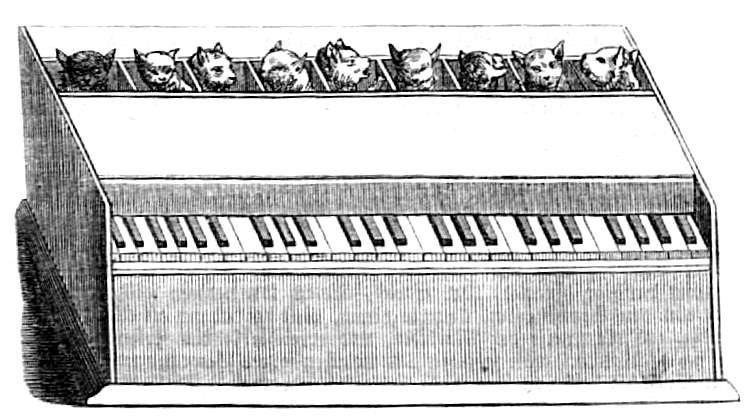The “Cat Organ” is a musical instrument consisting in which cats have their tails are stretched beneath the keys on a keyboard, so that they yelp in pain when a key is pressed. Press harder and softer to increase and decrease the volume. The cats would be arranged according to the natural tone of their voices.

From Gaspar Schott, Magia Naturalis (1657)
It is a sickening instrument of torture and blessedly one that, as far as we know, exists only in the imagination of a few dreamers, like French composer Jean-Baptiste Weckerlin (9 November 1821 – 20 May 1910), who described the cat organ in Musiciana. Extraits d’ouvrages rare ou bizarre [Musiciana. Descriptions of rare or bizarre inventions].
“When the King of Spain Felipe II was in Brussels in 1549 visiting his father the Emperor Charles V, each saw the other rejoicing at the sight of a completely singular procession. At the head marched an enormous bull whose horns were burning, between which there was also a small devil. Behind the bull a young boy sewn into a bear skin rode on a horse whose ears and tail were cut off. Then came the archangel Saint Michael in bright clothing, and carrying a balance in his hand.
“The most curious was on a chariot that carried the most singular music that can be imagined. It held a bear that played the organ; instead of pipes, there were sixteen cat heads each with its body confined; the tails were sticking out and were held to be played as the strings on a piano, if a key was pressed on the keyboard, the corresponding tail would be pulled hard, and it would produce each time a lamentable meow. The historian Juan Christoval Calvete, noted the cats were arranged properly to produce a succession of notes from the octave… (chromatically, I think).
“This abominable orchestra arranged itself inside a theatre where monkeys, wolves, deer and other animals danced to the sounds of this infernal music.”

Franz van der Wyngaert, “La lecture du grimoire” (early 17th c.)
German physician Johann Christian Reil (1759–1813), who would later coin the term “psychiatry, thought the cat organ would clear the mind of patients who’d lost the ability to focus.
“[Cats are] arranged in a row with their tails stretched behind them. And a keyboard fitted out with sharpened nails would be set over them. The struck cats would provide the sound. A fugue played on this instrument – when the ill person is so placed that he cannot miss the expression on their faces and the play of these animals–must bring Lot’s wife herself from her fixed state into conscious awareness.’
The idea of shocking them into reality is akin to the ‘Dead Cat Strategy’, aka deadcatting, the political trick of making a shocking announcement to divert attention away from problems or failures in other areas. While he was mayor of London, former UK Prime Minister Boris Johnson wrote a column for the 3 March 2013 edition of The Telegraph in which he described the “dead cat”:
There is one thing that is absolutely certain about throwing a dead cat on the dining room table – and I don’t mean that people will be outraged, alarmed, disgusted. That is true, but irrelevant. The key point, says my Australian friend, is that everyone will shout, ‘Jeez, mate, there’s a dead cat on the table!’ In other words, they will be talking about the dead cat – the thing you want them to talk about – and they will not be talking about the issue that has been causing you so much grief.”

Depiction in 1858 Die Gartenlaube short, Katzen-Orgel
The Jesuit scholar Athanasius Kircher (2 May 1602 – 27 November 1680) also mentioned the cat organ in his 1650 work Musurgia Universalis. Kircher thought that the instrument could alter the melancholy of princes by moving them to laughter.
“This remarkably clever instrument was built not so long ago to try to dispel the melancholy of the prince. Live cats of all sizes where placed in a box built for this purpose, containing sharp points near the tails so that they struck cats of different sizes, producing different pitches when different keys where pressed. The performance of this frenzy of cat voices in harmony, sometimes in misery, sometimes in anger, caused amusement.”
The theory was tested in 2010, when the then Prince of Wales and the Duchess of Cornwall were left laughing uncontrollably when Henry Dagg played his “cat organ” consisting of a row of squeaking toy – rather like this:
Lest we be accused of bias, in the interests of animal harmony here’s the Monty Python Mouse Organ:
And pigs. This (below) is the Piganino, a design by Abbe de Baigne inspired by Louis XI of France’s challenge to create a Musical instrument so preposterous it makes him less bored.

The piganino
No mice or cats were injured in theemaking of either of the previous recordings, although we’ve yet to hear from Marvin Suggs and his Muppophones:
Cats learn by watching – hence the term copycat – so we hope that if used once, the Cat Piano would soon play itself.
Would you like to support Flashbak?
Please consider making a donation to our site. We don't want to rely on ads to bring you the best of visual culture. You can also support us by signing up to our Mailing List. And you can also follow us on Facebook, Instagram and Twitter. For great art and culture delivered to your door, visit our shop.


